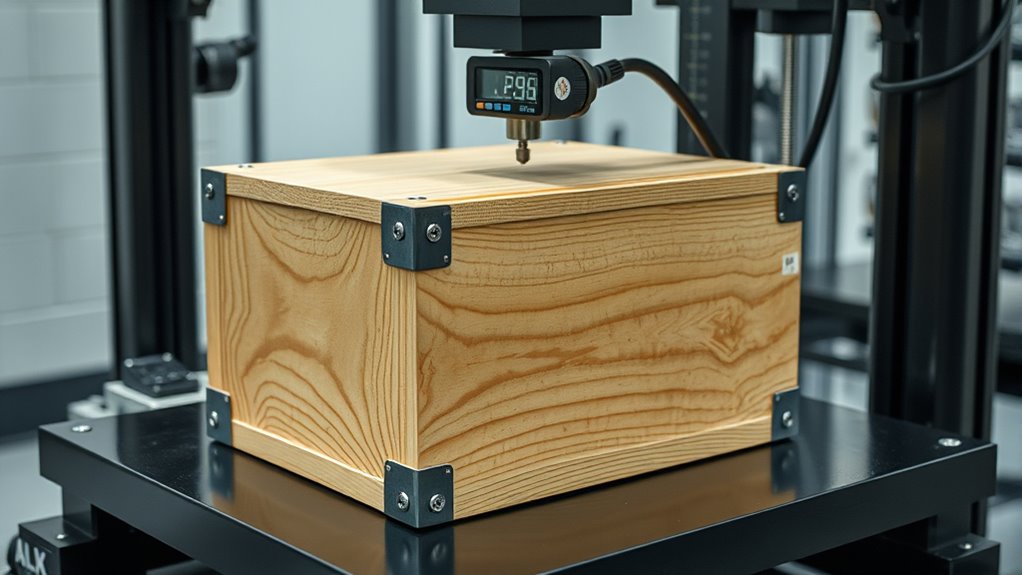To test box strength, you can use automated equipment that applies controlled forces to measure compression, vibration, and impact resistance, giving you precise, consistent results. Alternatively, manual inspection allows you to physically handle boxes, check for deformations, tears, and do simple compression tests by stacking or pressing. Combining both methods provides a thorough view of packaging durability, ensuring your boxes can withstand shipping stresses. Keep exploring to discover how these techniques can boost your packaging quality.
Key Takeaways
- Automated testing uses specialized equipment to measure a box’s resistance to compression, vibration, and impact with consistent results.
- Manual inspection involves physical handling, checking for deformations, tears, or weak points through simple compression or visual examination.
- Combining automated and manual methods provides comprehensive insights into box strength, ensuring both quantitative data and qualitative assessment.
- Regular testing maintains quality standards, helping optimize packaging design to withstand shipping and handling stresses effectively.
- Automated tests allow for large-scale screening and comparison of materials, supporting informed decisions in packaging development.

When selecting the right packaging for your products, understanding how to test box strength is vital. Strong packaging ensures your products arrive intact, reducing returns and customer complaints. To evaluate a box’s durability, you need trustworthy testing methods that accurately simulate real-world handling and shipping conditions. Two primary approaches are automated testing and manual inspection. Automated testing involves using specialized equipment to apply controlled forces to your boxes and measure their resistance. This method offers consistency, repeatability, and precise data collection. It’s ideal when you need to quickly screen large volumes of boxes or compare different packaging materials objectively. Automated systems can simulate compression, vibration, or impact forces, providing detailed insights into how your boxes perform under various stress scenarios. These tests help identify weak points and optimize box design before scaling up production. On the other hand, manual inspection lets you evaluate box strength through physical examination. It’s more subjective but valuable for initial assessments or when equipment isn’t available. During manual inspection, you physically handle the boxes, applying pressure to check for signs of weakness, such as deformations, tears, or compromised corners. You might also perform a simple compression test by stacking boxes or pressing down on them to observe how they hold up. While manual inspection doesn’t offer the same precision as automated testing, it provides immediate feedback and can uncover issues that machines might miss. For example, a box might pass an automated compression test but still show signs of weakness upon manual handling because of material inconsistencies or manufacturing flaws. Combining both methods delivers a thorough understanding of your packaging’s strength. Automated testing ensures quantitative, repeatable measurements, while manual inspection provides qualitative insights, catching issues that machines might overlook. When designing or selecting your boxes, consider starting with automated tests for baseline data and consistency, then incorporate manual inspections to catch subtler flaws. Regular testing, whether automated or manual, is essential as part of your quality control process. It helps you maintain high standards and adapt your packaging solutions based on real performance data. Remember, the goal is to create packaging that’s resilient enough to withstand the rigors of shipping and handling, ensuring your products reach customers in perfect condition. By understanding and applying these testing methods effectively, you’ll make smarter decisions about your packaging materials and design, ultimately saving costs and boosting customer satisfaction. Additionally, Honda Tuning principles can inspire innovative modifications to packaging structures, ensuring they are both durable and lightweight for easier handling.
Frequently Asked Questions
What Are the Latest Innovations in Box Strength Testing Technology?
You’ll find that the latest innovations in box strength testing technology include smart sensors and AI diagnostics. These advancements allow you to monitor and analyze box performance in real-time, providing precise data on load capacity and durability. Smart sensors detect weaknesses instantly, while AI diagnostics interpret the data to predict failure points, making your testing more efficient and accurate. This technology helps optimize packaging design and guarantees product safety during transit.
How Do Environmental Factors Affect Box Strength Test Results?
Environmental impact can substantially influence your box strength test results, as factors like temperature, humidity, and airflow affect material performance. These conditions may cause materials to weaken or become more rigid, skewing testing accuracy. To guarantee reliable results, you need to control environmental factors during testing or account for their effects. By doing so, you can accurately assess your box’s strength and ensure it meets your packaging standards.
Can Testing Methods Be Customized for Specific Packaging Industries?
Think of testing methods as a tailored suit; they can definitely be adapted for your packaging industry. You can develop industry-specific standards and customized testing protocols that precisely reflect your product’s unique needs. This ensures your packaging withstands real-world conditions. By customizing tests, you get more accurate results and better quality assurance, helping you optimize packaging design and reduce damage during transit.
What Are the Cost Differences Between Manual and Automated Testing?
You’ll find that manual testing typically costs less upfront but can become costly over time due to labor and inconsistency. Automated testing offers a higher initial investment but provides significant automation benefits like faster results, higher accuracy, and reduced labor costs. The cost comparison favors automation if you need high throughput and consistent results, making it more economical in the long run. Your choice depends on your testing volume and precision needs.
How Do Regulations Influence Box Strength Testing Standards Worldwide?
Regulations shape box strength testing standards worldwide more than you might think—they’re the backbone of ensuring safety and reliability. You must adhere to strict regulatory compliance and international standards, which vary by country but often align to prevent disaster. These rules influence testing methods, such as compression or edge crush tests, ensuring your boxes meet global safety benchmarks. Ignoring them risks not just fines but catastrophic failures in transit.
Conclusion
Think of box strength testing as a ship steering stormy seas. Each test is like a sturdy hull inspection, ensuring it can withstand the waves of shipping stress. When you choose the right method, you’re guiding your box safely through turbulent waters, confident it won’t sink under pressure. With proper testing, you become the captain of your packaging, steering it toward success, knowing it’s built to endure whatever storms come its way.










